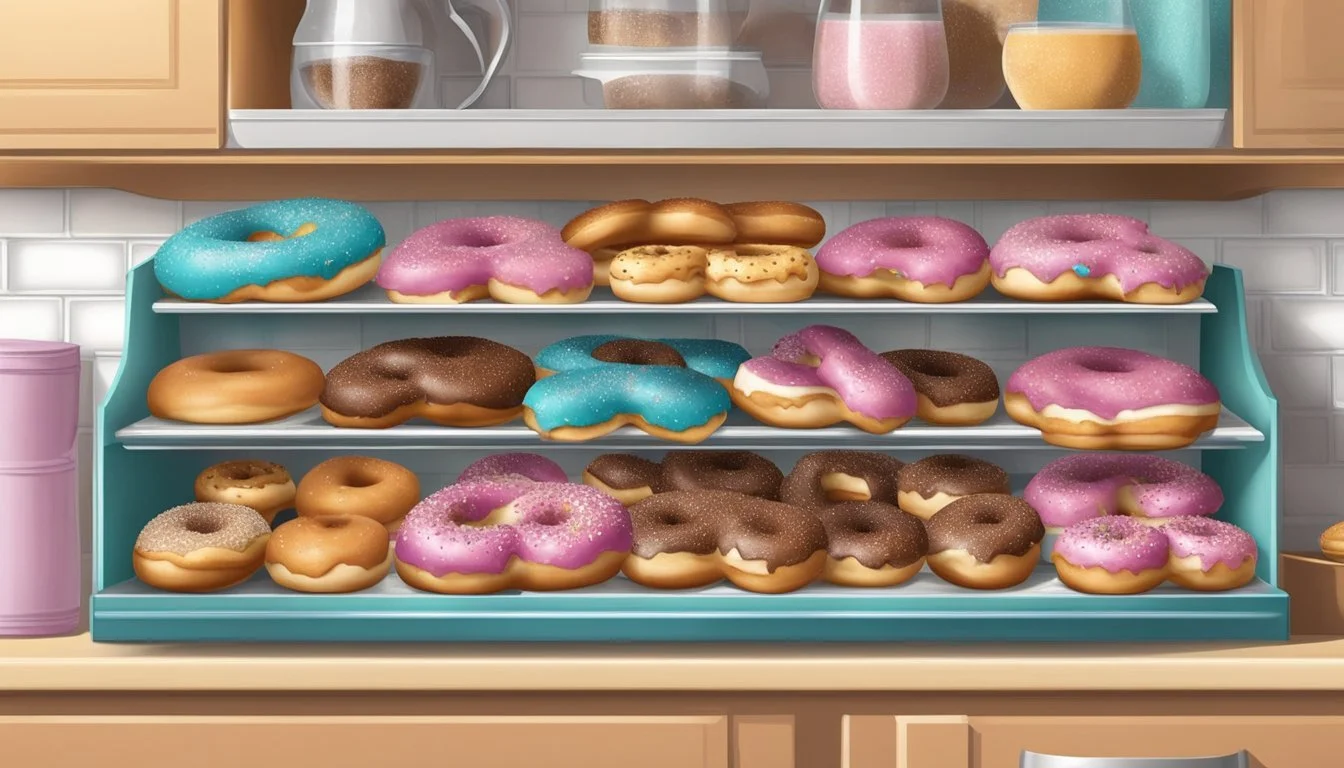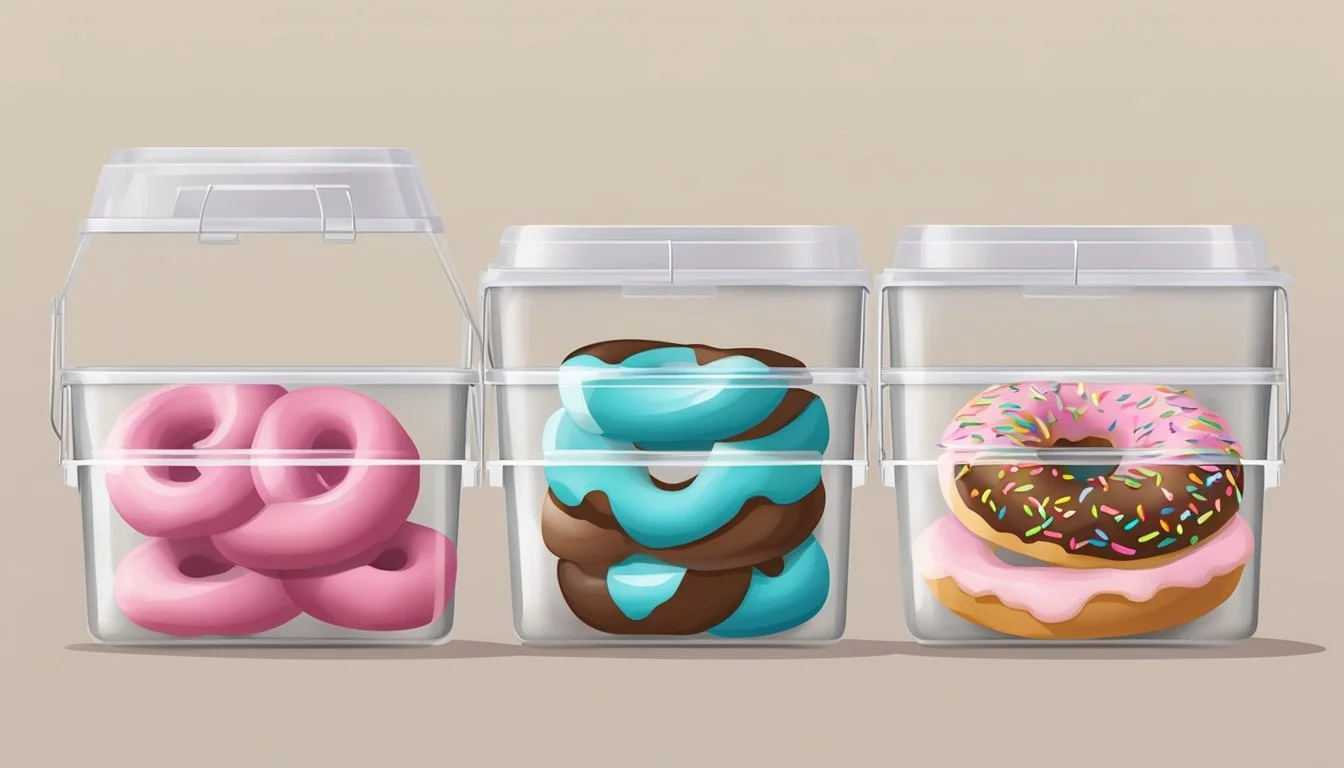Do Donuts Go Bad?
Shelf Life, Storage, and Signs of Spoilage
Do donuts go bad? Yes, like all perishable foods, donuts do deteriorate over time. Plain and glazed donuts typically stay fresh at room temperature for about 1-2 days, while filled varieties, like cream or jelly, should be consumed within 3-5 days if refrigerated. The shelf life of a donut hinges significantly on its ingredients and storage conditions.
Proper storage is crucial. Donuts are best kept in an airtight container to maintain their freshness. Cream-filled donuts must be refrigerated due to their dairy content, but even then, they only last a few days. If you want to extend their shelf life further, freezing can be an option, preserving them for up to three months.
These delicious treats can bring joy any time, but their quality diminishes quickly. Watching for signs like a stale or bad taste is essential to determine their edibility. Donuts may be rich in sugar and fat, but that doesn't immunize them from going bad. Understanding these factors helps in enjoying donuts at their peak flavor and freshness.
Understanding Donuts and Their Composition
Donuts can vary greatly in their type, fillings, and ingredients. Recognizing these differences can help in appreciating how each factor influences the donut's shelf life and quality.
Types of Donuts
Plain Donuts: These are basic donuts made without any extra toppings or fillings. They are often ring-shaped and can be enjoyed in their simplest form.
Glazed Donuts: These donuts have a sugary coat that adds sweetness and texture. The glaze can come in various flavors.
Filled Donuts: These are typically round without a hole and can be filled with sweet substances like jelly, cream, or custard.
Common Fillings and Toppings
Cream-Filled: Often filled with whipped cream, custard, or other dairy-based ingredients. These fillings are perishable and usually have a shorter shelf life.
Jelly: Popular in many filled donuts, jelly fillings add a burst of fruity flavor but can also lead to quicker spoilage.
Frosting and Glazes: Frostings can include chocolate, vanilla, or other flavors, adding an extra layer of sweetness. Glazes are usually a sugar-based coating that hardens on the outside.
Powdered: These donuts are coated in powdered sugar, giving them a sweet but messy finish.
Sprinkles: Often added on top of glazed or frosted donuts, sprinkles add color and a slight crunch.
Essential Ingredients
Flour: The main ingredient that gives donuts their structure. Different types of flour can influence the donut's texture.
Yeast or Baking Powder: These leavening agents help the donuts rise, making them fluffy and light.
Sugar and Milk: Necessary for sweetness and moisture, these ingredients contribute to the donut’s taste and softness.
Eggs: They provide richness and help bind the other ingredients together.
Butter or Oil: Adds flavor and helps in achieving a tender crumb. Some recipes might use margarine or shortening as alternatives.
Understanding these components helps to appreciate the variety and complexity of donuts. Different combinations of types, fillings, toppings, and ingredients influence the final product and its longevity.
Factors Influencing Donut Freshness
The freshness of donuts can be influenced by moisture, temperature, and the quality of ingredients used. Understanding these factors can help in maintaining their ideal texture and taste.
Moisture and Environmental Exposure
Moisture plays a crucial role in preserving the freshness of donuts. When exposed to high humidity, donuts can quickly become soggy and lose their texture. Conversely, low humidity can cause them to dry out.
Exposure to air and direct sunlight can accelerate staleness. Storing donuts in an airtight container helps prevent these effects, especially at room temperature. Avoid keeping donuts in open or poorly sealed containers to maintain their moisture levels.
Temperature and Storage Conditions
Temperature is a significant factor affecting a donut's shelf life. Donuts stored at room temperature in airtight containers can last 1-2 days. However, those with perishable fillings should be refrigerated to extend their freshness to 2-3 days.
Refrigeration slows down the spoilage process for cream-filled or jelly-filled donuts. However, it can alter the texture slightly, making them less appealing. Frozen donuts may retain their quality for 2 to 3 months, but proper packaging is essential to prevent freezer burn.
Ingredient Quality and Doughnut Types
The quality of ingredients and the type of donut also affect how long they remain fresh. High-quality flour, oils, and fillings contribute to better-tasting and longer-lasting donuts.
Plain and glazed donuts generally have a longer shelf life compared to those with fillings. Cream-filled and jelly-filled variants tend to spoil quicker due to their perishable contents. Choosing the right storage method for each type can significantly impact their freshness duration.
Shelf Life and Spoilage Indicators
Donuts, like many baked goods, have a limited shelf life which varies based on their type and storage conditions. It's crucial to identify signs of spoilage to ensure they're safe for consumption.
Visual and Olfactory Signs of Spoilage
The most obvious indicator of spoiled donuts is mold, which appears as green or white fuzzy patches. Stale donuts might not show visible signs but will become hard and lose their softness.
An off smell or bad smell suggests spoilage. Fresh donuts have a sweet, pleasant aroma, whereas spoiled ones may emit a sour or fermented odor. For filled donuts, signs of spoilage can include discoloration around the filling area, indicating the filling has gone bad.
Timeframe for Donut Consumption
The shelf life of donuts differs by type. Plain and glazed donuts remain fresh for about 1-2 days at room temperature. They can be refrigerated to extend their freshness up to a week.
Cream-filled and jelly-filled donuts have a shorter shelf life due to their perishable fillings. At room temperature, they last around 1-2 days. Refrigeration can keep them fresh for 3-5 days. Frozen donuts are best consumed within 2-3 months for optimal taste.
To maintain their quality, store donuts in airtight containers and consume them within their recommended timeframes. Always check for spoilage indicators before eating.
Proper Donut Storage Techniques
Donuts can stay fresh for varying durations depending on how they are stored. Different methods are suitable for short-term and long-term preservation, and each has its considerations for maintaining texture and taste.
Short-Term Storage Solutions
For short-term storage, keeping donuts at room temperature is typically most convenient. Plain and glazed donuts can remain fresh for about 1-2 days if stored in an airtight container on the counter.
Filled donuts like cream-filled and jelly-filled varieties have a shorter shelf life. They can be stored similarly but are likely to spoil faster due to their moist fillings. Place them in a container to prevent them from drying out but consume them within a day or two.
Long-Term Storage Solutions
For those looking to extend the shelf life of their donuts significantly, freezing is the best option. Wrap each donut individually in plastic wrap or aluminum foil, then place them in a freezer bag to avoid freezer burn.
Donuts, when stored properly, can last up to 2-3 months in the freezer. When ready to eat, thaw donuts at room temperature. This method preserves their flavor and texture much better than storing them in the fridge.
Refrigeration vs. Freezing
Refrigeration is not generally recommended for donuts, especially for short-term storage. Refrigeration can cause donuts to dry out and lose their texture quickly. If refrigeration is necessary, place donuts in an airtight container to help retain moisture but be aware they won't stay fresh for long.
Freezing is the preferred method for long-term storage. It successfully preserves the taste and consistency of the donuts. It is crucial to wrap donuts well to protect them from the cold air and to label them with dates to monitor how long they’ve been stored.
Best Practices for Extending Donut Freshness
To keep donuts fresh for an extended period, proper handling and storage techniques are essential. Additionally, knowing the most effective ways to thaw and reheat your donuts can ensure they taste just as good as when they were first made.
Handling and Sealing Methods
Proper handling and sealing play a significant role in maintaining donut freshness. Using an airtight container is one of the most effective ways to store donuts. This method prevents exposure to air, which can lead to drying out and staling.
Fresh donuts should be placed in the container as soon as possible. Make sure they are completely cooled before sealing them to avoid condensation, which can make them soggy.
For filled donuts, refrigeration is recommended. They often contain dairy-based fillings, which can spoil quickly at room temperature. To achieve the best result, always check for any signs of spoilage, such as mold or off textures.
Thawing and Reheating Tips
If you plan to freeze donuts, it’s essential to follow proper thawing and reheating methods to maintain their quality. Freezing donuts can extend their lifespan significantly, often up to 2-3 months. Place them in a single layer on a baking sheet to freeze initially, then transfer them to an airtight container or freezer bag.
When it comes to defrosting, let the donuts thaw at room temperature for about an hour. Avoid microwaving them directly from the freezer to prevent uneven heating.
For reheating, using a microwave or oven works well. For the microwave, heat the donut for about 10-15 seconds. If using an oven, preheat it to 350°F and warm the donut for 5-10 minutes. This method helps restore the texture and warmth without making the donut overly dry.
FAQs on Donut Quality and Consumption
Understanding the shelf life and proper storage of donuts is essential to ensure they remain safe to eat and enjoyable. It’s crucial to know how to determine if donuts are still good and what to do with leftovers.
Determining Consumption Safety
Donuts typically last 1-2 days at room temperature. Glazed donuts might stay fresh slightly longer, but filled donuts like those with cream or jelly fillings are more perishable.
To tell if a donut has gone bad, check for a few signs:
Smell: A sour or off odor.
Texture: Hard or overly dried out.
Mold: Any visible mold is a clear indicator to discard it.
Frequently, donuts with perishable fillings should be consumed within 1-2 days if stored at room temperature, or 3-5 days if refrigerated.
Dealing with Leftover Donuts
Leftover donuts should be stored properly to retain their freshness.
To maximize shelf life:
Room Temperature: Store plain or glazed donuts in an airtight container at room temperature for up to 2 days.
Refrigeration: Filled or cream donuts should be refrigerated, extending their life to 3-5 days.
Freezing: Freeze any donuts to keep them fresh for 2-3 months. When ready to eat, thaw at room temperature or briefly reheat.
Reheating donuts should be done carefully:
Microwave: Heat for 10-15 seconds to restore softness, avoiding overheating, which can cause fillings to become excessively hot.
Oven: Warm them at 350°F for a few minutes, watching closely to prevent burning.
Storing donuts correctly and reheating them cautiously ensures they remain delicious and safe to consume.







